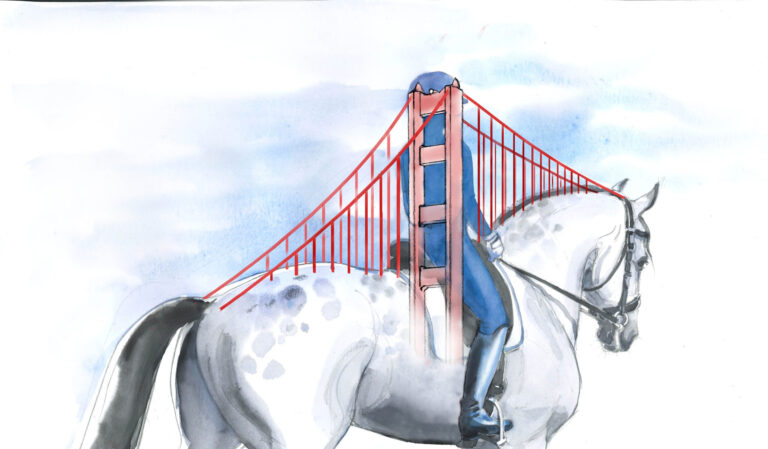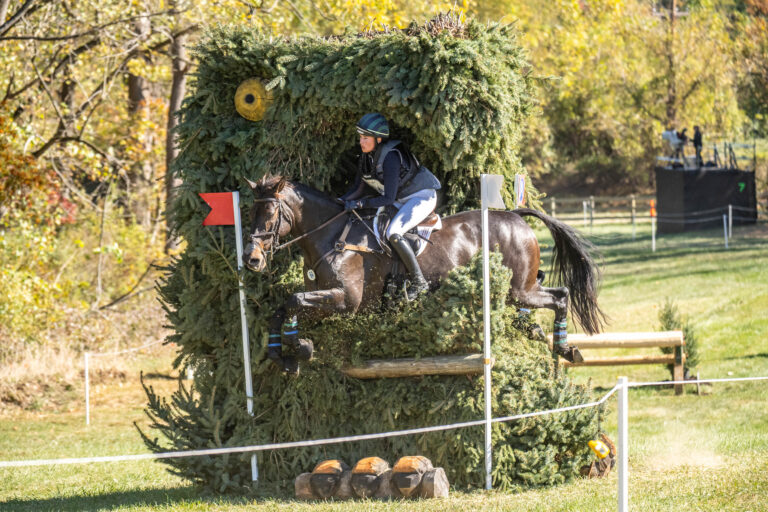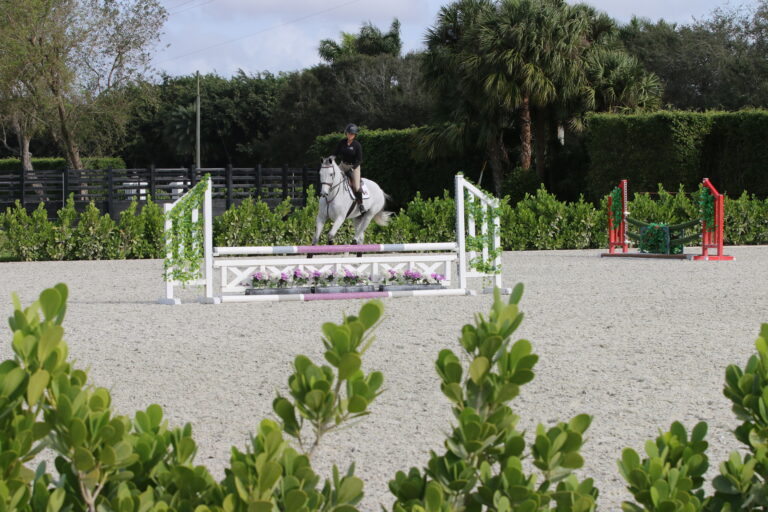Let me ask you something: If I longe a horse, can he jump an obstacle while on the longe? Sure. What about if I longe the horse over an obstacle and put a rider in the saddle? Same answer. OK, if I give the rider a blindfold and a neck strap, can the horse still jump? Where are you going with this, Jim? Of course the horse can still jump. But what if I blindfold the horse? Have you lost your mind?

No, I haven’t lost my mind … any more than usual. I just want to make sure we agree that the horse must see the fence. If we agree on that, it follows that to get the jump we want, we should understand what our horses see and how they see it. I think it is also important that riders see the fence, but I will get to the riders in a minute. Let’s talk about our horses first.
Although I have consulted several veterinarians and veterinary textbooks, I will spare you most of the scientific language and share, in plain English, what I discovered. Humans have binocular vision, which means we can change our field of focus without moving our heads. Unlike humans, horses have monocular vision, which means they have a fixed field of focus. They see objects in focus, but they have to change the attitude of their heads to change their focal points. Basically, they focus in line with the planes of their noses. You observe this when you turn a horse out in a paddock: He runs around for a minute, then usually stops and lifts his nose, surveying his environment for threats.
Your Horse’s Eyes
We have already decided that it is important for your horse to see the jump. My point here is that we now also know how he needs to carry his head and neck to see the next jump in focus.
Once we understand how your horse focuses his eyes, we need to determine where he focuses them. If we watch what horses do, the answer soon becomes apparent: Your horse looks at the top rail of the jump. Although you may have heard a great deal about ground lines, the truth is that once your horse learns how to jump, he transfers his focus from the ground line to the top rail. How do we know this? Very simple: your horse will successfully jump a hanging-rail vertical or even a two-rail oxer, which are obstacles with no ground line or filling at all.
Speaking of oxers, we now know that our horses focus their eyes, but what about depth perception? How does your horse measure his effort over a spread fence? Because horses have monocular vision, scientists tell us they cannot measure depth in the same way as humans, who have the advantage of binocular vision. Although I am usually guided by scientific findings, in this case I am more convinced by my observation of what horses actually do while jumping. The pragmatic answer about depth perception in horses is that although they do not see depth exactly as we do, somehow they do perceive depth and react to it correctly. Any rider with even limited experience has felt her horse change his body during takeoff. Quite often, horses will grunt with extra effort as they suddenly realize they have almost miscalculated the spread of an oxer or the width of a ditch.
Just as with depth perception, horses do not perceive color in the same way as humans; however, they react to color as if they see it. In years past, experts told me that horses see color in monochromatic shades of gray. More recent research indicates that horses have dichromatic color vision, while human vision is trichromatic. This means that horses will not see color the same way we do or be able to see as many different colors. Never mind. It does not matter to us exactly how our horses see color. What is important is that we recognize they do see color and train them accordingly, keeping in mind, for instance, that at competitions they will respond to color especially if they are a green 4-year-old just off the farm for the first time.
Another aspect of horses’ eyes is their ability to see in changing conditions of light and dark. This is especially important for eventers and foxhunters, but hunter and jumper riders might consider the implications when competing in a stadium environment with changing patterns of light and shade in the early morning or late afternoon. Again, I will try to boil down the scientific terminology about rods and cones to the part we need to know. Because a horse’s eye has a larger lens, he will see better in the dark than we do, but it will take the lens in his eye an extra bit of time to adjust. Horsemen have noticed this for generations. We teach inexperienced riders, for example, that if an obstacle is just inside a shade pool from bright sunlight, they need to make a slightly wider turn or slow the approach to give the horse time to adjust his eyesight to the changed light conditions.
I think the most important part of all the information above is that your horse points his nose at the rail to see the obstacle in focus. This should immediately inform our thinking about the correct frame for your horse as he approaches the obstacle. Many coaches still insist that your horse should approach in a dressage frame (“on the bit”). However, scientific research shows that to see the obstacle in focus, your horse needs to approach it with his nose pointed forward (while you ride him with a technique I refer to as “on the contact,” rather than “on the bit”). Although I realize this might be a new technique for you, I hope you are willing to give it a try in light of the scientific information we have gained.
One final point: Horses develop their “timing”–the ability to predict and influence the remaining strides before an obstacle–in the same manner as humans (as I’m about to explain), by focusing on the jump. Every time your horse moves his head and neck during the approach, he must take one more stride after his head and neck are still, before he can refocus his gaze and recompute his stride to the next obstacle. You have probably heard from your coaches that they want your hands and your horse’s head and neck to be quiet in the approach. It is hard for your horse to see the jump if his head is moving.
Meanwhile, the Eyes in the Saddle
And speaking of things we have heard in the past, what about the rider’s eyes? Most riders are still taught to look above the obstacle. Many coaches are quite adamant about this, claiming that the rider who looks at the obstacle will anticipate and look down as she jumps. However, I disagree with the practice of looking away from the obstacle–again, based on scientific studies and books I have read.
My own thinking changed in the mid-1970s after I read The Inner Game of Tennis by W. Timothy Gallwey. (I was playing some club-level tennis at the time and wanted to improve, so as usual, I turned to books for the answer.) The author made a good case for looking intently at the tennis ball until your racquet connected with it. I instinctively find connections between my readings in other fields and horses, so naturally I became curious about what would happen if I looked at the obstacle I was jumping, instead of looking beyond it as I had been taught from early childhood. Scientists tell us that to measure distance we need a fixed point of reference. It follows that if we look above the jumping obstacle we see into infinity, but we do not have a fixed point of reference that helps us measure how many strides remain before our takeoff point.
I found immediately that if I looked at the obstacle during my approach, my timing improved, but I was now looking down at the obstacle in the air, rather than landing looking forward. After some experimentation, I discovered that I needed to keep my eye on the top of the obstacle until it went out of sight between my horse’s ears, at which time I needed to look ahead for the next obstacle. Over time, I decided that I needed to look at the same place my horse was looking and developed the following guidelines for my students, based on the five basic types of obstacles:
1. Vertical: Look at the top of the rail, plank, gate, etc.
2. Parallel (also referred to as an oxer): Look at the front rail of the oxer unless it is less than or equal to half the height of the back rail, in which case I want riders to transfer their eyes to the back rail.
3. Staircase (triple bars): Look at the back (highest) rail.
4. Pyramid (hog’s back, rolltops, etc.): Look at the middle (highest) rail.
5. Open ditch (or open water): Look at the back tape or revetment.
In the past, I have maintained my teachings regarding the use of the rider’s eyes based solely on my own opinion. Fortunately for me, there is now some scientific research specifically regarding the use of the rider’s eyes while jumping. Nottingham Trent University in the United Kingdom recently conducted a study whose findings stated, “When approaching a jump, riders rapidly alter their point of gaze from the ground in front of a jump to the jump itself and then to the ground beyond. However, the more experienced show-jump rider was found to fix his gaze on the jump much sooner than each of the other riders up to 3.05 seconds earlier before takeoff than the least experienced noncompetitive rider. The top rider also spent significantly longer fixated on each point.” This study underlines the importance of what is referred to as “predictive eye movements.” I now have scientific research to back up one of my favorite teaching aphorisms: “You can’t see your stride if you can’t see the fence.”
Although I disagree with it, the practice of looking above the obstacle is pervasive and actually worked quite well … until the first related distance was introduced. It then became outmoded, because it was now necessary for the rider to be aware of the remaining increments of stride and to influence them. This is hard to do if you can’t see the fence.
About Jim Wofford
Longtime Practical Horseman columnist Jim Wofford competed in three Olympic Games and two World Championships. He also won the U.S. National Championship five times. Additionally he was also a highly respected coach. For decades beginning in 1978, he had at least one student on every U.S. Olympic, World Championship and Pan American team. He passed away February 2, 2023.
This article originally appeared in the December 2012 issue of Practical Horseman.











